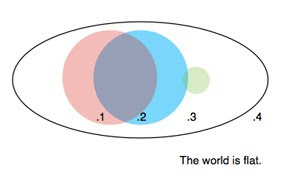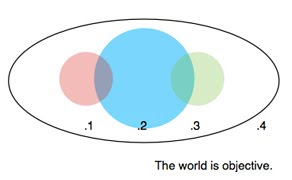
Most people have heard of Galileo (1564-1642) and some people have heard of Nicolaus Copernicus (1473-1543), but I'll provide a quick thumbnail refresher for anyone who might have forgotten. Galileo was an Italian physicist, mathematician, astronomer, and philosopher who played a major role in the Scientific Revolution. One of several reasons included his support of a theory proposed by Copernicus that the Earth not the center of the universe.
It must have seemed a silly notion at the time. It would be several decades before Isaac Newton would formulate the theory of gravity, which basically meant people would fall off this little blue marble we call home. But mostly, it monkeyed up Geocentrism.
Yet, against the tide of popularity, Copernicus must have looked like a simple idiot. Actually, he looked worse than that. He was censored as a heretic and was buried in an unmarked grave beneath the floor of a cathedral. Except, he wasn't a heretic. He was in need of a better telescope, like the one used by Galileo. Not that a telescope helped Galileo. He was persecuted too. What he really needed was a better communication model because most people, at the time, still believed the world to be flat (let alone the center of the universe).
The World Is Flat.
 To appreciate why Galileo needed a better communication model, we must consider what his world must have been like. My guess is that it would have looked grossly disproportionate to the facts.
To appreciate why Galileo needed a better communication model, we must consider what his world must have been like. My guess is that it would have looked grossly disproportionate to the facts. Looking at a model, Galileo was a mere pebble. I even had to inflate his size so he would show up in a post.
1. Geocentricism loyalists. 2. Undecided and blind followers. 3. Copernicus detractors. 4. And then there is the whole of the greater world that does not care if we live on a disc, pillar, ball, or bouncy house. It's hard enough for them to remember to wash before supper.
Can you imagine how many votes Galileo would earn on Quora? How many people would read his blog? How many people might follow him on Twitter? I doubt anyone would find him on Facebook. People were stoned and barbecued for less. What a dope.
The World Is Objective.
 No matter, many people might say. Modern communication bears these things out nicely today. As mass communication took hold, people began to realize that there were three positions people with awareness could take.
No matter, many people might say. Modern communication bears these things out nicely today. As mass communication took hold, people began to realize that there were three positions people with awareness could take. In the 1920s, for example, Walter Lippmann understood that journalism's role served people best when it acted as a mediator or translator between the public and policy making elites. Suffice to say, Lippmann would have read the Geocentricism argument and then read the Galileo argument and objectively reported to the masses that the guy with a telescope had a point.
1. Geocentricism. 2. Undecided. 3. Copernicus. 4. Bouncy house.
For many years, this was the model that politics theorized about. The world is largely made up of people who are unaware. And within that unawareness is a smaller group of aware people with opinions. This made politics obvious, because if you shifted that middle by even a fraction of one percent, you changed everything. All you had to do is present the facts.
The World Is Polarized.
 In more recent years, there has been a shift in the way politics is handled. During the last couple of decades some strategists concluded that battling over the middle was becoming a bit boorish. It was ever so difficult to get anything done and nobody appreciated the compromise anyway.
In more recent years, there has been a shift in the way politics is handled. During the last couple of decades some strategists concluded that battling over the middle was becoming a bit boorish. It was ever so difficult to get anything done and nobody appreciated the compromise anyway. So some strategists developed a system to strengthen the conviction of loyalists, discredit the detractors, and shrink the greater pool of the unaware. Applied to Galileo, the two factions would have debated bitterly and nothing would get done, ever.
1. Geocentricism. 2. Undecided. 3. Copernicus. 4. Bouncy house.
Sure, I know what some people are thinking. What about the media? Aren't they supposed to balance this stuff out?
They would have, but the media decided, for several reasons, that balance no longer means being objective. It really just meant giving polarized views attention, and then letting people sort it out for themselves, even if those people had trouble remembering to wash their hands before supper. It didn't take long for this view to change up too, as the middle slowly lost more and more of its buying power.
The World Is Social.
 When nothing gets done, people grow discontent. And sometimes, much like they did more than 200 years ago in this country, they start taking matters into their own hands. About 200 years ago, the tool was the printing press. Today, technology gave us social media.
When nothing gets done, people grow discontent. And sometimes, much like they did more than 200 years ago in this country, they start taking matters into their own hands. About 200 years ago, the tool was the printing press. Today, technology gave us social media.Unfortunately, the new model is a bit more complicated than a printing press. It makes much more apparent that each layer consists of not one sphere, but several overlapping spheres built on the connectivity of relationships that have nothing to do with the validity of the topic. Oh well, it still looks prettier.
1. Believe in bouncy house theory, but meet a Geocentrist at a bar. 2. Loosely related to a Geocentrist. 3. Geocentricism. 4. Benefit from Geocentricism. 5. Undecided but owe a Geocentrist a favor. 6. Undecided. 7. Undecided but owe a Copernicus a favor. 8. Benefit from Copernicus. 9. Copernicus. 10. Loosely related to a Copernicus. 11. Believe in bouncy house theory, but meet a Copernicus at a bar. 12. Bouncy house.
The advent of social media created an entirely new system based on this model. And as it developed, it wasn't long before some people realized that as their loyalist pools shrank, it was advantageous to connect with more people at a bar. They didn't have to know what you were talking about; they only had to know you. In some cases, it was probably better if they didn't know what you were talking about.
The benefit of this model in Galileo's time would have been making decisions quickly and decisively. He would have gathered up everyone he met a bar, bathhouse, and local pond where the women did wash and then perform a head count, maybe even drawing a cow as an illustration to appease a crowd-sourced holdout. The Geocentricists would have done the same.
And what do you know, simple math suggests that the outcome would have been the same as it was more than 400 years ago.
The World Is Round.
 How could that happen? It might be tricky to figure out, but only because the new model looks so much prettier.
How could that happen? It might be tricky to figure out, but only because the new model looks so much prettier. The model being employed by social today is the same model that was employed in the flat world. Except instead of an oppressive authority over mindless followers, we have popular authority over mindless followers.
There is only a small benefit between the two. Galileo wouldn't be censored; he would be ridiculed instead. And while some might argue that he would just have to work a little harder to develop a bigger network of bar buddies, it seems like a pretty daunting task to chase down an idea that had a 1,000-year head start.
I am sure Galileo might have given it a go. But nowadays, some experts are preaching the better solution would be to listen to the masses. He should have said we live on a bouncy house, they tell me.
The only tiny little problem with that notion? The world really is round, in case you didn't know.
Related articles on influence.
• What Are Influencers Good For?
• Measuring Influence: 4 Learnings.
• Influencing Nothing: Social Media Influencers.

















